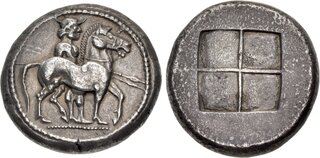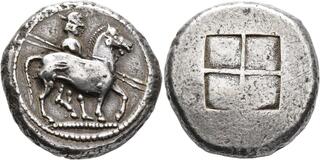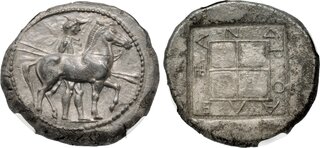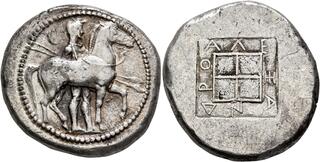Match 1:
| Classical Numismatic Group > Auction 126 | Auction date: 28 May 2024 |
| Lot number: 123 Price realized: This lot is for sale in an upcoming auction - Bid on this lot  | |
| Lot description: KINGS of MACEDON. Alexander I. 498-454 BC. AR Tristater – "Oktadrachm" (30.5mm, 28.43 g). Light Aeginetic standard. Aigai mint. Struck circa 476/5-460 BC. Horseman, wearing chlamys and petasos, and holding two spears, standing right behind horse advancing right / Quadripartite incuse square. Raymond pl. II, 4; AMNG III p. 49, 7 (Bisaltai); HPM pl. XII, 2 (Bisaltai); SNG ANS 1; Athena Fund I 21 (same obv. die); Boston MFA 617 (Bisaltai); Gillet 739; Pozzi 696 = Rhousopoulos 1006 (Bisaltai). Attractive cabinet tone. EF. From the Wild Rose Collection. Ex Triton XXII (8 January 2019), lot 185; Osaka Collection (Hess-Divo 334, 29 May 2018), lot 40, assembled prior to 2000. By the end of the sixth century BC, the Kingdom of Macedon became an influential regional power, strategically located between the Persian Empire and the city-states of Greece. The wars with Persia further extended Macedon's importance, especially that of its young prince, Alexander I, the son of Amyntas. An astute politician, Alexander deftly maneuvered through this precarious situation. Although he early on offered his sister's hand in marriage to a Persian to offset punishment for his revenge against the high handedness of a Persian embassy in 514-513 BC, Alexander maintained an aloof but cordial relationship with the Persians as they moved through the region in 492 BC, forcing the other tribes to Medize. At the same time, he worked towards a stronger association with the Greeks. Herodotos (9.44) says that on the eve of the battle at Plataia, Alexander entered the Athenian camp to report that a delay in engaging the Persians would help to further diminish their already low supplies. In return, he hoped the Greeks (in particular the Athenians) would assist him when the time came, thereby forging a relationship between the rising power in the north with the rising Greek city-states of Athens, Sparta and their allies. This coin type had long been ascribed to the Bisaltai, one of the powerful Thraco-Macedonian tribes that struck coinage in the late 6th and early 5th centuries. The weight of the evidence now points to it being the earliest issue of Alexander I, when he was allied with the tribes against the Persians; he presumably struck coins with types that were acceptable to his allies and would, in fact, symbolize their alliance. For a discussion of the weight standard of this issue, see S. Psoma, "Did the So-Called Thraco-Macedonian Standard Exist?" in KAIPOΣ, pp. 167–90. Estimate: 10000 USD |  |
Match 2:
| Leu Numismatik AG > Auction 15 | Auction date: 1 June 2024 |
| Lot number: 50 Price realized: This lot is for sale in an upcoming auction - Bid on this lot  | |
| Lot description: KINGS OF MACEDON. Alexander I (?), 498-454 BC. Tristater or Oktadrachm (Silver, 30 mm, 29.47 g), circa 480s-470s BC. Horseman, wearing chlamys and petasos, holding two javelins and walking slowly to right behind bridled horse standing right, left foreleg raised; on the flank of the horse, symbol or monogram (?). Rev. Quadripartite incuse square. AMNG III, p. 49, 6 ('Bisaltai'). S. Brackmann: Alexandros I. oder Bisaltai, in: JNG 65 (2015), pp. 1-8. HGC 3.1, 753. Peykov A3020 ('Bisaltai'). Raymond pl. II, 5. SNG ANS 1. SNG Lockett 1266 ('Bisaltai'). Svoronos, HPM, pl. XII, 6 ('Bisaltai'). Tzamalis, Ethné, Groupe B.2., 129 and pl. 28, 129 (this coin, D51/R52). Very rare. A beautifully toned and unusually well struck example with a fine pedigree. Minor doubling on the obverse and with light scratches on the reverse, otherwise, very fine. Ex Classical Numismatic Auctions 1, 1 May 1987, 30, Sternberg XIV, 24-25 May 1984, 65, Leu 28, 5 May 1981, 72 and Münzen & Medaillen AG XIX, 5 June 1959, 384 ('Magnifique example d'art archaïque, rustique et spontané. D'une grande rareté.'). Given that both the Bisaltai and Alexander I issued this type with the addition of an ethnikon or royal name, the attribution of anonymous pieces like ours remains contentious. Brackmann highlighted reverse die links to pieces bearing the name of the Bisaltai tribe, yet this merely suggests that the coins were produced in the same mint, not that they were issued by and for the Bisaltai, as he himself admits. Many scholars perceive the lack of inscription as suggesting an early production date for the coins. However, it is possible that these coins represent alliance coinages between the Macedonian King and the tribal community, with deliberate omission of names for political expediency. We have adopted the more common attribution to Alexander I here, albeit with a lingering question mark since consensus regarding their origin has yet to be reached. What remains undeniable, however, is that these impressive large silver coins - whether tristaters or oktadrachms - fit well within the broader context of minting large silver denominations in the Thracian-Macedonian region, as previously discussed in the commentary on lot number 40 above. Estimate: 7500 CHF |  |
Match 3:
Match 4:
| Eid Mar Auctions GmbH > Auction 3 | Auction date: 11 May 2024 |
| Lot number: 47 Price realized: This lot is for sale in an upcoming auction - Bid on this lot  | |
| Lot description: Greek Kings of Macedon. Alexander I 498-454 BC. AR Tetrobol (14mm, 1,7 g.). Light standard. Aigai mint. Struck circa 480/79-477/6 BC. Horse stepping right. Rev. Helmet right in linear square within shallow incuse square. Raymond Group IV, Series 1; HGC 3, 774. Nicely toned and about Good Very Fine. Scarce. Estimate: 50 EUR Starting price: 40 EUR |  |
Match 5:







